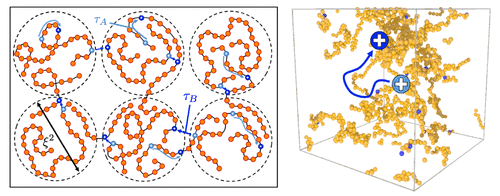当前位置:
X-MOL 学术
›
Macromolecules
›
论文详情
Our official English website, www.x-mol.net, welcomes your feedback! (Note: you will need to create a separate account there.)
Mechanisms of Diffusive Charge Transport in Redox-Active Polymer Solutions
Macromolecules ( IF 5.5 ) Pub Date : 2020-09-10 , DOI: 10.1021/acs.macromol.0c01672 Liliana Bello 1 , Charles E. Sing 1
Macromolecules ( IF 5.5 ) Pub Date : 2020-09-10 , DOI: 10.1021/acs.macromol.0c01672 Liliana Bello 1 , Charles E. Sing 1
Affiliation

|
Redox-active polymers (RAPs) have pendant groups that can change their charge state due to an electrochemical driving force. There has been an interest in using RAPs as a charge storage medium in redox flow batteries due to their ability to take on charge combined with their large macromolecular size. The performance of these batteries is in part tied to the transport of charge within these RAP solutions, and consequently there has been a recent effort to understand the physics governing charge diffusion in RAP systems. These efforts have highlighted the key role of both intra- and intermolecular charge transport mechanisms in governing their electrochemical response; however, little is known about how the molecular structure of polyelectrolyte solutions affects these proposed mechanisms. In this paper, we develop a coarse-grained, hybrid Brownian dynamics and kinetic Monte Carlo simulation to study charge transport in RAP solutions. We show how a number of different transport mechanisms interplay, including the intrapolymer transport of charge both along the chain via self-exchange transport and polymer segmental motions as well as hopping due to interpolymer collisions and translational diffusion of the chains themselves. We provide theoretical arguments to describe the diffusive motion of charge via these mechanisms, which match well with simulation results. Our predictions suggest the existence of three distinct regimes of charge transport, which distinguish between inter- and intramolecular processes and dilute and semidilute solutions.
中文翻译:

氧化还原活性聚合物溶液中扩散性电荷传输的机理
氧化还原活性聚合物(RAP)的侧基可由于电化学驱动力而改变其电荷状态。由于RAP具有承受电荷的能力以及大分子的大小,因此人们将RAP用作氧化还原液流电池中的电荷存储介质。这些电池的性能部分与这些RAP解决方案中的电荷传输有关,因此,最近人们在努力研究控制RAP系统中电荷扩散的物理原理。这些努力突出了分子内和分子间电荷传输机制在控制其电化学反应中的关键作用。然而,关于聚电解质溶液的分子结构如何影响这些提出的机制知之甚少。在本文中,我们开发了一种粗粒度的,混合布朗动力学和动力学蒙特卡洛模拟研究RAP解决方案中的电荷传输。我们展示了许多不同的传输机制如何相互作用,包括通过自交换传输和聚合物链段运动沿着链沿链内进行的聚合物内传输,以及由于链间聚合物间碰撞和平移扩散而引起的跳跃。我们提供理论论据来描述通过这些机制的电荷的扩散运动,这与仿真结果非常吻合。我们的预测表明存在三种不同的电荷传输机制,它们区分了分子间和分子内过程以及稀溶液和半稀溶液。我们展示了许多不同的传输机制如何相互作用,包括通过自交换传输和聚合物链段运动沿着链沿链内进行的聚合物内传输,以及由于链间聚合物间碰撞和平移扩散而引起的跳跃。我们提供理论论据来描述通过这些机制的电荷的扩散运动,这与仿真结果非常吻合。我们的预测表明存在三种不同的电荷传输机制,它们区分了分子间和分子内过程以及稀溶液和半稀溶液。我们显示了许多不同的传输机制如何相互作用,包括通过自交换传输和聚合物链段运动沿着链沿链进行的聚合物内传输,以及由于链间聚合物之间的碰撞和平移扩散而引起的跳跃。我们提供理论论据来描述通过这些机制的电荷的扩散运动,这与仿真结果非常吻合。我们的预测表明存在三种不同的电荷传输机制,它们区分了分子间和分子内过程以及稀溶液和半稀溶液。包括通过自交换传输和聚合物分段运动沿着链在链内进行的聚合物内传输,以及由于链间自身发生互聚物碰撞和平移扩散而引起的跳跃。我们提供理论论据来描述通过这些机制的电荷的扩散运动,这与仿真结果非常吻合。我们的预测表明存在三种不同的电荷传输机制,它们区分了分子间和分子内过程以及稀溶液和半稀溶液。包括通过自交换传输和聚合物分段运动沿着链在链内进行的聚合物内传输,以及由于链间自身发生互聚物碰撞和平移扩散而引起的跳跃。我们提供理论论据来描述通过这些机制的电荷的扩散运动,这与仿真结果非常吻合。我们的预测表明存在三种不同的电荷传输机制,它们区分了分子间和分子内过程以及稀溶液和半稀溶液。
更新日期:2020-09-22
中文翻译:

氧化还原活性聚合物溶液中扩散性电荷传输的机理
氧化还原活性聚合物(RAP)的侧基可由于电化学驱动力而改变其电荷状态。由于RAP具有承受电荷的能力以及大分子的大小,因此人们将RAP用作氧化还原液流电池中的电荷存储介质。这些电池的性能部分与这些RAP解决方案中的电荷传输有关,因此,最近人们在努力研究控制RAP系统中电荷扩散的物理原理。这些努力突出了分子内和分子间电荷传输机制在控制其电化学反应中的关键作用。然而,关于聚电解质溶液的分子结构如何影响这些提出的机制知之甚少。在本文中,我们开发了一种粗粒度的,混合布朗动力学和动力学蒙特卡洛模拟研究RAP解决方案中的电荷传输。我们展示了许多不同的传输机制如何相互作用,包括通过自交换传输和聚合物链段运动沿着链沿链内进行的聚合物内传输,以及由于链间聚合物间碰撞和平移扩散而引起的跳跃。我们提供理论论据来描述通过这些机制的电荷的扩散运动,这与仿真结果非常吻合。我们的预测表明存在三种不同的电荷传输机制,它们区分了分子间和分子内过程以及稀溶液和半稀溶液。我们展示了许多不同的传输机制如何相互作用,包括通过自交换传输和聚合物链段运动沿着链沿链内进行的聚合物内传输,以及由于链间聚合物间碰撞和平移扩散而引起的跳跃。我们提供理论论据来描述通过这些机制的电荷的扩散运动,这与仿真结果非常吻合。我们的预测表明存在三种不同的电荷传输机制,它们区分了分子间和分子内过程以及稀溶液和半稀溶液。我们显示了许多不同的传输机制如何相互作用,包括通过自交换传输和聚合物链段运动沿着链沿链进行的聚合物内传输,以及由于链间聚合物之间的碰撞和平移扩散而引起的跳跃。我们提供理论论据来描述通过这些机制的电荷的扩散运动,这与仿真结果非常吻合。我们的预测表明存在三种不同的电荷传输机制,它们区分了分子间和分子内过程以及稀溶液和半稀溶液。包括通过自交换传输和聚合物分段运动沿着链在链内进行的聚合物内传输,以及由于链间自身发生互聚物碰撞和平移扩散而引起的跳跃。我们提供理论论据来描述通过这些机制的电荷的扩散运动,这与仿真结果非常吻合。我们的预测表明存在三种不同的电荷传输机制,它们区分了分子间和分子内过程以及稀溶液和半稀溶液。包括通过自交换传输和聚合物分段运动沿着链在链内进行的聚合物内传输,以及由于链间自身发生互聚物碰撞和平移扩散而引起的跳跃。我们提供理论论据来描述通过这些机制的电荷的扩散运动,这与仿真结果非常吻合。我们的预测表明存在三种不同的电荷传输机制,它们区分了分子间和分子内过程以及稀溶液和半稀溶液。


























 京公网安备 11010802027423号
京公网安备 11010802027423号